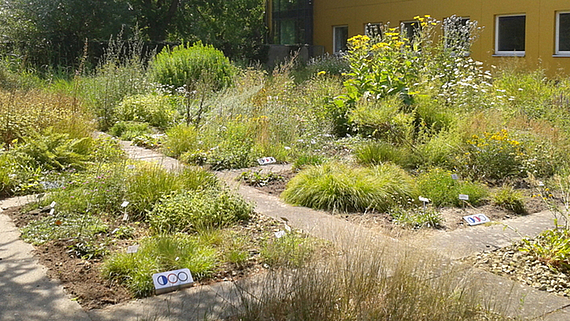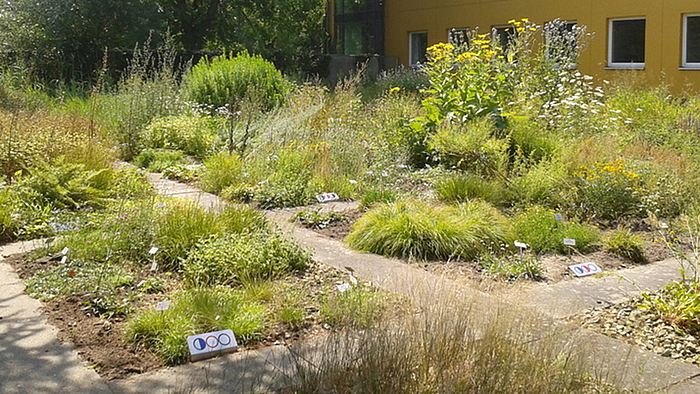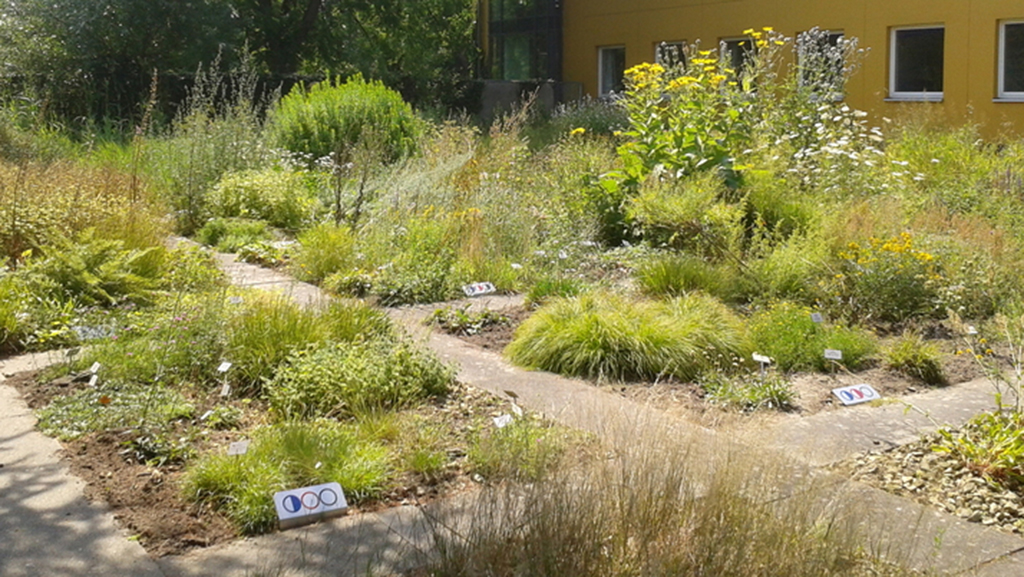Indicator plants nursery
at the Institute for Environmental Planning



Between the university buildings at Herrenhäuser Str. 2 and 2A there is a garden whose variety and colourfulness invites you to discover, explore and linger from spring to autumn.
In 1976 Prof. Dr. Franz H. Meyer developed a teaching garden with plants indicating the location. The indicator values for moisture, reaction and nitrogen content of the soil developed by Prof. Dr. Heinz Ellenberg served as an ordering system.
-
Information about the garden
For the planting of the indicator plant garden in Germany, wild, mainly perennial plant species with narrow site amplitudes were selected and compiled in 24 combinations of the above-mentioned indicator values.
Based on this information, garden visitors can inform themselves about the typical site preferences of all species presented (in the 'open landscape', not in the garden!). Even if many plant species growing alone tolerate a wide range of different environmental conditions and thrive best with an average water and nutrient supply (auto-ecological optimum), the range of tolerated environmental conditions shifts and decreases in competition with other species (syn-ecological optimum).
As a result, we can distinguish, for example, between dryness and wetness indicators, acidity and lime indicators, leanness and nitrogen indicators.
Rudolf Thinius, gardener at the Institute for Landscape Management and Nature Conservation from 1975 to 2006, laid out the garden. As part of a change to the original concept, his successor Christiane Hausmann created raised beds filled with gravel and sand from 2006 onwards as a location for drought-bearing plants; foils helped to establish wet to moist areas. The grid of slab paths is explained in a showcase; it separates the beds from one another and allows access to all species.
The plant material needed to establish the garden was supplied by the neighbouring Berggarten, the Burg Botanical School Garden, the Wild Herbaceous Garden of the University of Veterinary Medicine and many botanical gardens from all over Germany. Teachers and students also brought and still bring plant species from their travels. Only five years after its foundation, the Pointer Plants Garden was in a respectable condition and has since provided material for lectures, determination exercises and self-study.
Today more than 500 species grow in the beds. About a third of them are on the Red List of endangered plant species in Lower Saxony. About 100 other species can be found in the border area of the garden. Typical North German habitats such as grey dune, salt marsh and bog are presented here, while the south-facing edge is home to species suitable for planting in sunny areas.
Since 2001, the Institute for Environmental Planning with its Pointer Plants Garden has participated in the campaign "Open Gate - Gardens in and around Hannover", and school classes are also welcome guests.
In 2010 the Mitteldeutsche Rundfunk (MDR) visited the project and introduced the Pointer Plants Garden to its viewers (see video).
On weekdays, as long as the university buildings are open, the Pointer Plants Garden is available to all interested parties for independent exploration and can be reached via the main entrance at Herrenhäuser Straße 2. Guided tours can be arranged.
- Teaching material for the garden
- Wild plants in Hannover
-
Contact person
Christiane Hausmann, Dipl.-Ing.Administrative/Technical Staff
PhoneFaxAddressHerrenhäuser Straße 2
30419 HannoverBuildingRoomScientific conception
Prof. Dr. rer. nat. Rüdiger PrasseEmeritus/Retired Professors
